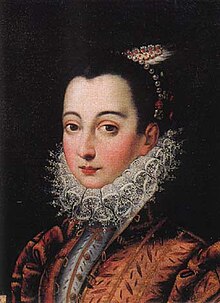Vittoria Accoramboni: Difference between revisions
Buchraeumer (talk | contribs) No edit summary |
Added infobox and image |
||
| Line 1: | Line 1: | ||
'''Vittoria Accoramboni''' (15 February 1557 – 22 December 1585) was an [[Italy|Italian]] noblewoman. Her life became the basis for three stories and two novels. |
'''Vittoria Accoramboni''' (15 February 1557 – 22 December 1585) was an [[Italy|Italian]] noblewoman. Her life became the basis for three stories and two novels. |
||
{{Infobox noble|type |
|||
| name = |
|||
| title = |
|||
| image = [[File:Vittoria Accoramboni by Scipione Pulzone.jpg|thumb|Vittoria Accoramboni by Scipione Pulzone]] |
|||
| caption = |
|||
| alt = |
|||
| CoA = |
|||
| more = no |
|||
| succession = |
|||
| reign = |
|||
| reign-type = |
|||
| predecessor = |
|||
| successor = |
|||
| suc-type = |
|||
| spouse = |
|||
| spouse-type = |
|||
| issue = |
|||
| issue-link = |
|||
| issue-pipe = |
|||
| full name = |
|||
| styles = |
|||
| titles = |
|||
| noble family = |
|||
| house-type = |
|||
| father = |
|||
| mother = |
|||
| birth_date = <!-- {{Birth date and age|YYYY|MM|DD|df=y}} --> |
|||
| birth_place = |
|||
| christening_date = |
|||
| christening_place = |
|||
| death_date = <!-- {{Death date and age|YYYY|MM|DD|YYYY|MM|DD|df=y}} --> |
|||
| death_place = |
|||
| burial_date = |
|||
| burial_place = |
|||
| religion = |
|||
| occupation = |
|||
| memorials = |
|||
| url = <!-- {{{URL|example.com}} --> |
|||
| module = |
|||
}} |
|||
==Biography== |
==Biography== |
||
She was born in [[Gubbio]], the tenth child in a family belonging to the minor nobility of Gubbio, which migrated to [[Rome]] with a view to bettering their fortunes. After refusing several offers of marriage for Vittoria, her father betrothed her to [[Francesco Peretti]], a man of no position, but a nephew of [[Cardinal Montalto]], who was regarded as likely to become pope. |
She was born in [[Gubbio]], the tenth child in a family belonging to the minor nobility of Gubbio, which migrated to [[Rome]] with a view to bettering their fortunes. After refusing several offers of marriage for Vittoria, her father betrothed her to [[Francesco Peretti]], a man of no position, but a nephew of [[Cardinal Montalto]], who was regarded as likely to become pope. |
||
Revision as of 09:47, 5 September 2014
Vittoria Accoramboni (15 February 1557 – 22 December 1585) was an Italian noblewoman. Her life became the basis for three stories and two novels.
Vittoria Accoramboni | |
|---|---|
 |
Biography
She was born in Gubbio, the tenth child in a family belonging to the minor nobility of Gubbio, which migrated to Rome with a view to bettering their fortunes. After refusing several offers of marriage for Vittoria, her father betrothed her to Francesco Peretti, a man of no position, but a nephew of Cardinal Montalto, who was regarded as likely to become pope.
Vittoria was admired and worshipped by all the cleverest and most brilliant men in Rome, and being luxurious and extravagant although poor, she and her husband were soon plunged in debt. Among her most fervent admirers was Paolo Giordano I Orsini, duke of Bracciano, one of the most powerful men in Rome. Her brother Marcello, wishing to see her the duke's wife, had Peretti murdered (1581). The duke himself was suspected of complicity, inasmuch as he was believed to have murdered his first wife, Isabella de' Medici. Now that Vittoria was free he made her an offer of marriage, which she willingly accepted, and they were married shortly after.
But her good fortune aroused much jealousy, and attempts were made to annul the marriage; she was imprisoned in the Castel Sant'Angelo and only liberated through the intervention of Cardinal Carlo Borromeo. On the death of Pope Gregory XIII, Cardinal Montalto, her first husband's uncle, was elected in his place as Sixtus V (1585); he vowed vengeance on the duke of Bracciano and Vittoria, who, warned in time, fled first to Venice and thence to Salò in Venetian territory. Here the duke died in November 1585, bequeathing to his widow all his personal property. The duchy of Bracciano passed to his son by his first wife.
Vittoria, overwhelmed with grief, went to live in retirement at Padua, where she was followed by Lodovico Orsini, a relation of her late husband and a servant of the Venetian republic, to arrange amicably for the division of the property. But a quarrel having arisen in this connection, Lodovico hired a band of bravi and had Vittoria assassinated at the end of 1585. He himself and nearly all his accomplices were afterwards put to death by order of the republic.
References in literature
Her story formed the basis of John Webster's drama tragedy, The White Devil, or The Tragedy of Paolo Giordano Ursini, Duke of Brachiano (1612), of Stendhal's novella Vittoria Accoramboni (1837-1839), of Ludwig Tieck's novel, Vittoria Accoramboni (1840) and of Robert Merle's novel l'Idole (1987) published in English translation as Vittoria.
References
- Attribution
This article incorporates text from a publication now in the public domain: Chisholm, Hugh, ed. (1911). "Accoramboni, Vittoria". Encyclopædia Britannica. Vol. 1 (11th ed.). Cambridge University Press. p. 122. Further references cited:
- D. Gnoli's volume, Vittoria Accoramboni (Florence, 1870),
- an excellent sketch of her life is given in E. Martinengo-Cesaresco's Lombard Studies (London, 1902)
